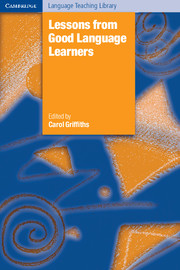Book contents
- Frontmatter
- Contents
- List of contributors
- Acknowledgements
- Editor's overview
- Prologue
- Reflections
- Part I Learner variables
- Part II Learning variables
- 12 Vocabulary and good language learners
- 13 Grammar and good language learners
- 14 Functions and good language learners
- 15 Pronunciation and good language learners
- 16 Listening and good language learners
- 17 Speaking and good language learners
- 18 Reading and good language learners
- 19 Writing and good language learners
- 20 Teaching/learning method and good language learners
- 21 Strategy instruction and good language learners
- 22 Errors correction and good language learners
- 23 Tasks and good language learners
- The learners' landscape and journey: a summary
- Index
18 - Reading and good language learners
Published online by Cambridge University Press: 11 August 2009
- Frontmatter
- Contents
- List of contributors
- Acknowledgements
- Editor's overview
- Prologue
- Reflections
- Part I Learner variables
- Part II Learning variables
- 12 Vocabulary and good language learners
- 13 Grammar and good language learners
- 14 Functions and good language learners
- 15 Pronunciation and good language learners
- 16 Listening and good language learners
- 17 Speaking and good language learners
- 18 Reading and good language learners
- 19 Writing and good language learners
- 20 Teaching/learning method and good language learners
- 21 Strategy instruction and good language learners
- 22 Errors correction and good language learners
- 23 Tasks and good language learners
- The learners' landscape and journey: a summary
- Index
Summary
Although in a first language, linguistic input is usually initially received via listening (see White, this volume), it is often via reading that students are exposed to a language other than their first. This chapter explores the target language reading process of good language learners. Before we look at empirical examples from speakers of other languages learning to read in English that highlight the importance of action-orientation in the target language reading classroom, wewill briefly explore the interactive cognitive processes involved in reading. The chapter concludes with implications for the teaching and learning of target language reading.
Target language reading as a cognitive process
When we enjoy our newspaper or a good book, we are usually unaware of how amazingly complex a skill reading is. As language teachers, however, we often observe our students experiencing comprehension problems that make us wonder how the process of reading might work in the mind, and how we can best support our bilingual or multilingual students who are trying to develop reading skills in a new language.
Several disciplines – psychology, linguistics, and education, in particular – are involved in researching reading and have constantly refined their research methodology to inquire into this elusive process, hidden from direct observation. Research methods span a wide continuum from highly controlled psycholinguistic experiments (using, for example, eye movement tracking, reaction times to linguistic stimuli, or neurophysiological measurements such as brain scans), to ethnographic studies that rely on participant observation, documentation, interpretation, and discussion with informants in authentic reading contexts over extended periods of time.
- Type
- Chapter
- Information
- Lessons from Good Language Learners , pp. 231 - 243Publisher: Cambridge University PressPrint publication year: 2008
- 2
- Cited by



